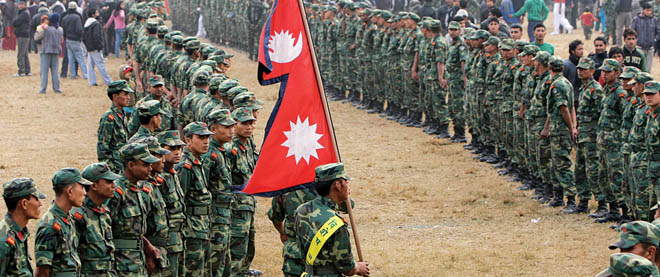What to do with the Maoists in Nepal?
Reintegrating the former guerrillas after a decade-long civil war remains a divisive issue
Prakash Mathema/AFP/Getty Images
Share

Disagreements over the implementation of an agreement to release thousands of former Maoist fighters from enclosed camps in Nepal are threatening to snuff out hopes that an ongoing political stalemate can give way to the country’s long-awaited rebirth.
In early November, the coalition government of Prime Minister Baburam Bhattarai—himself the face of the former Maoist insurgency—struck a long-sought accord with opposition parties to release 19,000 Maoist soldiers from UN-monitored camps. Under the agreement, 6,500 of those soldiers would be integrated into the Nepalese army; the rest would be given roughly 800,000 rupees ($10,000) to start a new life. The accord promised to bring some closure to a decade-long civil war that killed more than 16,000 people. A further 100,000 were uprooted from their homes in the conflict, which featured jungle shootouts, extrajudicial executions, bombings and assassinations as Maoist rebels tried to overthrow the government in Kathmandu and replace the existing constitutional monarchy with a federal republic.
After the fighting ended in 2006, the question of what to do with the Maoist soldiers was deeply divisive for the political parties jockeying for influence in Kathmandu. In a 2009 report, UN Secretary-General Ban Ki-moon wrote that the issue “is one important indication of the wider tensions between the political parties, which could imperil the completion of the peace process.” Indeed, since Nepal’s last elections in 2008, political infighting has resulted in five different coalition governments. Now, many contend this agreement may be the last chance for the currently elected politicians to draft and implement the long-promised constitution that would complete the country’s transformation to a republic after the abolition of the monarchy more than three years ago.
But tensions flared up in December when Bhattarai asked for the agreement to be modified. As the BBC reported, double the expected number of former fighters wanted to join Nepal’s army. Sushil Koirala, leader of the opposition Nepali Congress Party, refused Bhattarai’s request, saying his party would “stand firm” on the November agreement, and also called on the Maoist party to fulfill its long-standing promise to return land seized during the war to its original owners. But the issue also appears to be creating a rift within the Maoist party, some of whose members are expressing doubts about the process. Speaking with India’s Zee News on Jan. 8, Maoist hardliner Mohan Vaidya called the party leadership “opportunists” and criticized the agreement as an impediment to the “people’s revolution.”
Thanks largely to this political instability, little economic development has been able to take root. Postwar Nepal remains one of the world’s poorest countries—a quarter of the population toils beneath the poverty line—even though it has massive hydroelectric energy capabilities. But as former opponents continue to squabble, they remain untapped—leaving the people of Nepal still waiting for a new era.